According to the American Veterinary Medical Association, responsible pet owners must ensure “access to appropriate food, water, and shelter.” Our pets give us their unconditional love and affection without asking for anything in return. It’s our privilege as pet parents to meet their needs and ensure their health and happiness. A healthy, nutrient-rich diet is as essential to their health as clean water, shelter, and medication.
So, what’s the big deal about healthy pet food brands? Are they really that much better for your pets than inexpensive food you can pick up at any corner store? As it turns out, the answer isn’t as clear-cut as you may be expecting.
If you ask the experts at Cummings Veterinary Medical Center at Tufts University, food labels can be misleading. Ultimately, it doesn’t matter what the packaging boasts if the nutrition labels tell another story. From unclear nutrition labels to celebrity endorsements, there’s a gray area around what makes for the best pet food brands. Let’s look closer.

How to read a food label
While many pet food brands hype up their products with claims such as “holistic” or “natural” one of the most informative pieces of information to look for is the Nutritional Adequacy statement, also known as an AAFCO statement. Using nutritional information published by the Association of American Feed Control Officials (AAFCO), Nutritional Adequacy statements measure several factors:
- Does this food provide vital nutrients?
- If so, what organization made this determination?
- For what stage of life is this food developed?
Most often, Nutritional Adequacy statements are found in small print on the back or side of the bag. You’ll want to find something along the lines of “This food is formulated to meet AAFCO nutrient profiles for dogs of all life stages.” However, some foods are labeled as being intended for supplemental feeding only, which means they don’t contain the complete nutrients your pet needs for a healthy diet.

How do healthy pet food brands measure up?
Several pet food brands are touted as the be-all and end-all of healthy pet food. Each of the following recipes lists its AAFCO nutrient profile, which is always a good sign. But are they actually any good?
Arcana
The first three ingredients listed on the Arcana Red Meat Formula are deboned beef, deboned pork, and beef meal. Beef meal may sound like a useless byproduct, but as it contains almost 300% more protein than fresh beef, it’s a fantastic source of nutritional protein.
With added protein from six legumes, healthy fats from beef fat and pollock oil, which also contains essential omega-3 fatty acids, inulin (a source of dietary fiber that doubles as a prebiotic), and a chelated mineral that aids in nutritional absorption, Arcana’s recipes are quite healthy.
Castor and Pollux Organix Grain-Free Small Breed
With organic chicken, organic chicken meal, and organic sweet potatoes as the top three ingredients in Castor and Pollux Organix, you can rest assured that your dog’s food is free of pesticides, antibiotics, and hormones. Added vitamin supplements, inulin, and amino acids provide essential nutrition. Carbs like peas and tapioca starch improve energy levels. Also included? Coconut oil, a medium-chain fatty acid that can help give cognitive function a boost.
Orijen
One of the most popular healthy pet foods around, Orijen Original Formula’s top ingredients are deboned chicken, deboned turkey, and flounder. You’ll also find fresh and dehydrated eggs, organ meat like chicken heart, liver, and kidney, turkey heart, and cartilage. Apples and pumpkin aid in digestion, as does Lactobacillus acidophilus. Mackerel gives a boost of omega-3 fatty acids. Legumes provide extra protein and essential carbohydrates.

What makes pet food healthy?
Now that you know what to look for on the label, it’s time to delve into what makes some pet foods healthier than others. High-quality pet foods provide better nutrition, which improves your pet’s quality of life. They’ll be less likely to experience allergic reactions and digestive issues if their diet is packed with nutritious meats, vegetables, and minerals. Here’s what you should look for — and what to avoid.
- The first ingredient in your pet’s food should be meat. High-protein foods are essential for pets. Meats like chicken, fish, beef, pork, and lamb are common.
- Look for carbohydrates. While cats have no need for carbohydrates in their food, carbs are important to your dog’s health, so look for foods enhanced with legumes or potatoes.
- Avoid artificial dyes and preservatives. The liver and kidneys serve as filters for the body, so foods that are jampacked with artificial dyes, preservatives, and chemicals take a lot of work by these organs to remove. Similarly, fillers and byproducts don’t add nutritional value and only help your pet feel full.
- Limit grains. Grains aren’t the devil, but you’ll want to look out for wheat, corn, and soy fillers, which are used to bulk up your pet’s food without providing nutrition. They’re also common allergens, which can cause itching, skin irritation, and severe digestive issues.
Your pet’s health matters, and good food is intrinsically linked to good health. Speak to your vet about your pet’s dietary needs and look for foods that provide essential protein, fats, vitamins, and minerals. When in doubt, check the Pet Nutrition Alliance chart to ensure your pet’s food meets her needs.
Editors' Recommendations
- Are ‘dog years’ really 7 human years? How to calculate your dog’s age
- How to tell if your older dog’s health decline means the end is near
- Xylitol is dangerous for dogs: 10 surprising products that contain it as a hidden ingredient
- When do kittens start eating food? Know the facts for your fur baby’s health
- Do puppies sleep a lot? These are the perfectly normal sleeping habits of a healthy pup




